Chicago Solar Eclipse 2024: Where and when to see path of totality on April 8
CHICAGO - The upcoming total solar eclipse, set to illuminate the skies from Texas to Maine on April 8, promises a spectacular display, with southern Illinois emerging as a prime location to witness the celestial event.
While Chicago won't be in the path of totality, the eclipse is expected to offer a breathtaking show in the city. Chicago and the surrounding suburbs will experience a partial eclipse, with an estimated 94% totality.
During the eclipse, the moon will appear to block most of the sun in Chicagoland. The sky will become noticeably darker, similar to what you would see at twilight.

What you need to know ahead of the solar eclipse
We are just hours away from a celestial spectacular. A total eclipse is arriving Monday, within about 140 miles of Chicago. Nate Rodgers has the story.
The partial eclipse will be visible in Chicago from 12:51 p.m. to 3:22 p.m., reaching peak totality at 2:07 p.m. Since Chicagoland is not in the path of totality, it will not be safe to view the eclipse without eclipse glasses or other tools.
The last time Chicagoland was this close to the path of totality for a total solar eclipse was in 2017, when the totality reached 90% — and before that the area hadn't seen one since 1869!
Where to View in Chicago Suburbs
- Aurora: 93% totality at 2:06 p.m.
- Elgin: 92% totality at 2:06 p.m.
- Crystal Lake: 91% totality at 2:06 p.m.
- Joliet: 94% totality at 2:06 p.m.
- Naperville: 94% totality at 2:06 p.m.
- Schaumburg: 93% totality at 2:07 p.m.
- Waukegan: 92% totality at 2:07 p.m.
- Kankakee: 96% totality at 2:06 p.m.
Chicago Eclipse Events
The Adler Planetarium on April 8 is hosting a free public event from 12:30 p.m. to 3:30 p.m. to showcase the solar eclipse. Telescopes will be set up around the Planetarium grounds and attendees are encouraged to observe the sky.
The Pullman National Historic Park has its "A Partial Eclipse in the Park" event from 1 p.m. to 3 p.m. Family-friendly activities and snacks will be provided.
The Museum of Science and Industry has its solar eclipse event from 10 a.m. to 3:30 p.m. There will be several actives and attendees can view the eclipse through a telescope.
The Chicago Public Library is also hosting events at some of its branches, including at the Legler Regional and Budlong Woods locations.
Additionally, the East Dundee Library in Chicago's northwest suburbs will be hosting a solar eclipse event. The Skokie and Elmhurst park districts, as well as Triton College, will also host events.
What is a Total Solar Eclipse?
A total solar eclipse occurs when the Moon passes between the Sun and the Earth, completely obscuring the Sun's face for several minutes. The process, from partial eclipse through totality, spans several hours and features phenomena such as Baily's Beads and the Diamond Ring caused by the Moon's pockmarked surface.

Tips for viewing the last total solar eclipse for 20 years
Mother Nature is putting together quite a show for all to see on April 8. It?s going to be the last total solar eclipse that we will see for the next 20 years and Illinois has some of the best seats to offer.
Baily's Beads is named after British astronomer Francis Baily, who discovered the eclipse phenomenon. This effect looks like beads of light poking out from around the Moon's shadow. It happens because the Moon's rugged terrain allows sunlight to pass through before totality.
Eventually, the beads disappear and become one bright spot of sunlight resembling a giant diamond in the sky, with the Sun's atmosphere forming the ring's band. Seeing the Diamond Ring is a sign that totality is almost there.
During Baily's Beads and Diamond Ring, you still need to keep your eclipse glasses on. Only during the few minutes of totality is it safe to remove your glasses.
What does Totality mean?
Totality in an eclipse is when the moon fully obscures the sun, allowing observers within the path of the moon's shadow to witness it. When totality occurs, the corona (the sun's outer atmosphere) becomes visible as a halo surrounding the moon. The day is plunged into twilight, stars and planets may become visible in the sky, and the temperature drops as much as 10 degrees. This period of totality is typically quite short – a few minutes, tops – but it can have a profound impact on those who experience it.
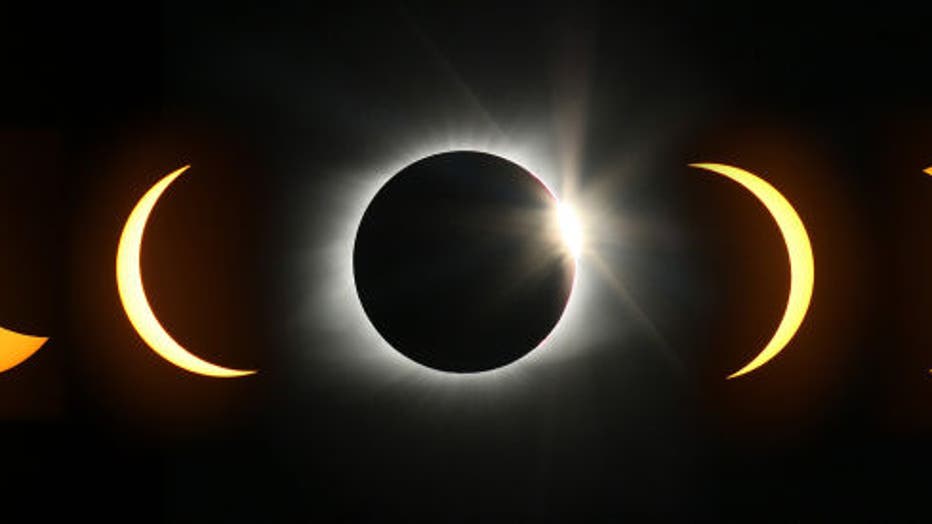
A composite image of eight pictures shows the phases of the total eclipse as the moon passes from left to right in front of the sun during a solar eclipse on Monday, Aug. 21, 2017, near Perryville, Mo. Shot with an equivalent of an 800mm lens, the pa
Where to View in Illinois
Numerous cities and towns in southern Illinois will lie in the path of totality.
The eclipse's trajectory, moving from southwest to northeast, will encompass cities like Cairo, Olive Branch, Grand Tower, Red Bud, Carbondale, Mount Vernon, Harrisburg, and Fairfield before reaching communities near the Indiana border such as Olney and Robinson. They all lie in the path of totality and will be plunged into darkness for up to a few minutes.
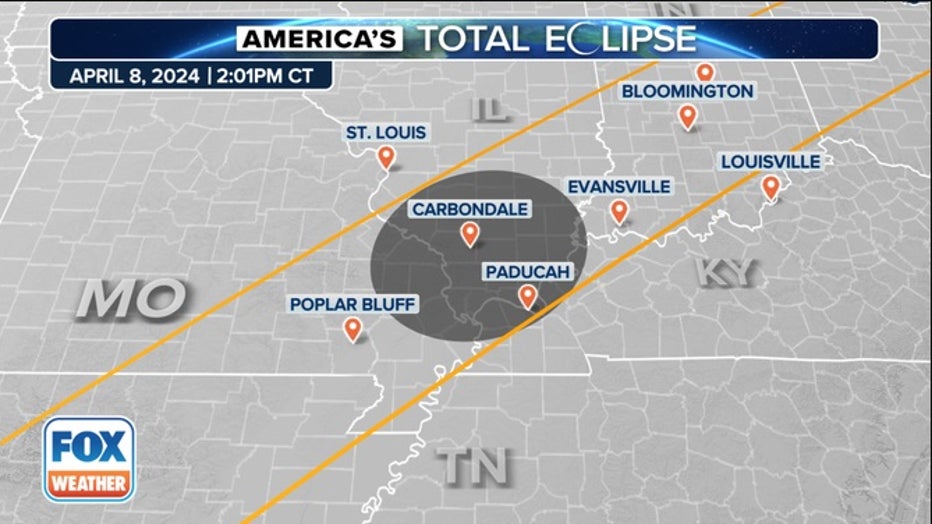
Total solar eclipse path for Illinois on April 8, 2024. (FOX Weather)
Timing of the Eclipse
The total solar eclipse is an event lasting several hours, with totality lasting from a few seconds to over four minutes, contingent upon one's location within the 115-mile path of totality.
In Grand Tower, the eclipse will commence at 12:42 p.m. CDT, with totality beginning at 1:58 p.m. and lasting until 2:02 p.m., concluding at 3:17 p.m.
Carbondale will experience the eclipse starting at 12:43 p.m. CDT, with totality commencing at 1:59 p.m., lasting for 4 minutes and 9 seconds until 2:03 p.m., and ending at 3:18 p.m.
Robinson will witness the eclipse beginning at 12:47 p.m. CDT, with totality starting at 2:03 p.m. and lasting for 3 minutes and 39 seconds until 2:06 p.m., concluding at 3:20 p.m.
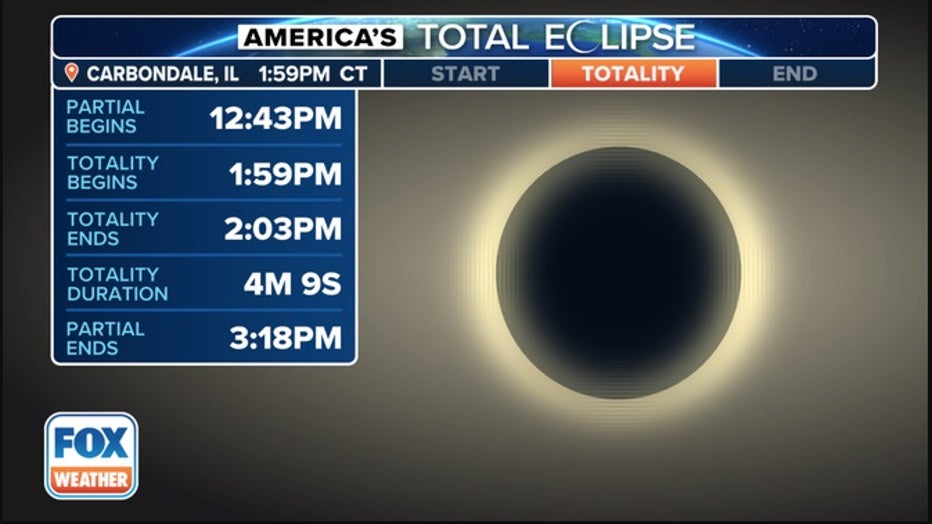
The total eclipse times in Carbondale, Illinois, on April 8, 2024. (FOX Weather)
What Will I See During the Eclipse?
If you are in the path of totality:
The moon will appear to completely block the sun for as long as seven and a half minutes. Daytime will turn into near night during that time and the sun’s corona – the outer rays – may be visible.
If you are not far from the path of totality:
The moon will appear to block most of the sun. It will still become noticeably darker; daylight will become more like twilight.
If you are well outside the path of totality:
You’ll notice a chunk of the sun is being blocked. The farther away you are, the smaller the moon’s bite will appear to be. In Seattle and Portland, Oregon, about as far away as you can get in the continental U.S., one-third of the sun will be swallowed.
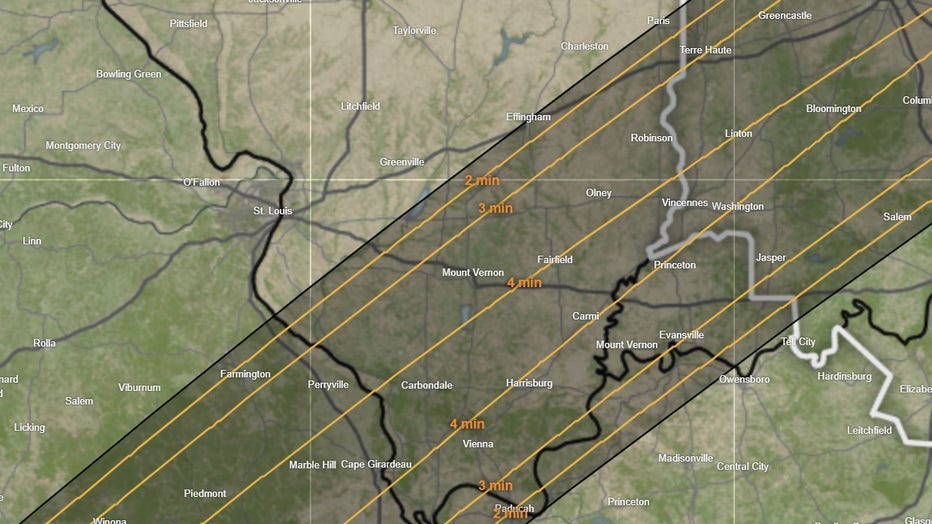
The length of totality in southern Illinois is shown in orange | NASA
Weather Forecast
Clear skies are crucial for observing a total solar eclipse. Some cloud cover is in the forecast on April 8, but we will have a better idea of how things are looking as we get closer to Monday.
Check back with FOX 32 Chicago for weather updates, and download our apps for the latest news and forecasts.
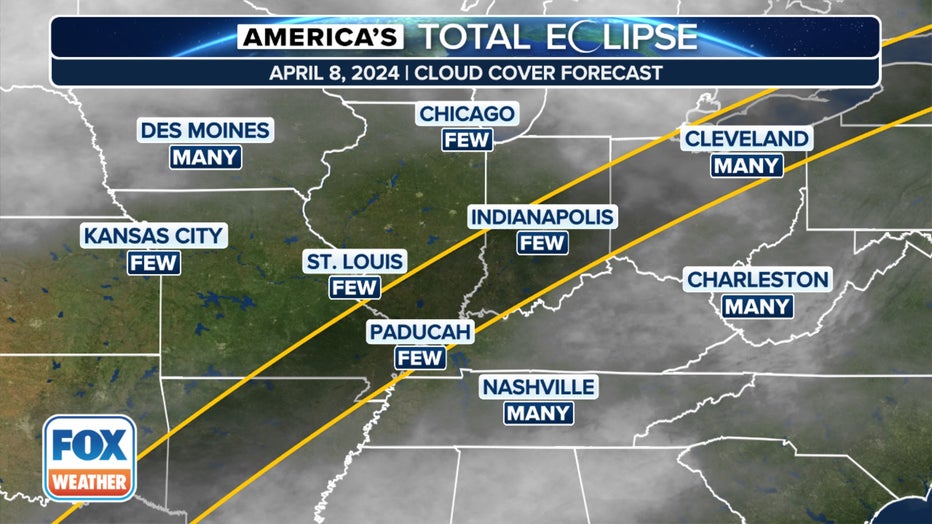
The eclipse cloud cover forecast from FOX Weather.
Traveling to Illinois for the Eclipse
This marks the second total solar eclipse in southern Illinois within seven years, with Carbondale positioned in the path of totality once again.
"For a location to be in the path of two eclipses in a seven-year time span is literally unheard of," said Sarah Vanvooren, director of events and outreach at Southern Illinois University (SIU).
SIU is preparing to host the Southern Illinois Eclipse Crossroads of America Festival from April 5-8. NASA also launched a website with other events taking place in Illinois leading up to, and on the day of, the eclipse.
Meanwhile, various agencies are warning that anyone who is traveling to see the eclipse should plan ahead, allow extra time for travel, and be patient with the influx of traffic that's expected. There may also be limited parking at whichever viewing area you settle on.
Where Can I Get Eclipse Glasses?
Solar eclipse glasses are essential if you want to look at the eclipse itself. Even with the moon partially blocking it, the sun will still be strong enough to damage your eyes.
Many businesses are giving away glasses for free; you can find a list HERE.
If you can’t get eclipse glasses, welder’s glasses can work but only if they are rated with the darkest shade level of 14.
An eclipse viewing box, which projects a shadow of the eclipse, may be a safer option for young children. Here’s how to make one.
How to Know if Your Eclipse Glasses are Safe
Solar filters are used in eclipse glasses and handheld viewers and meet a very specific worldwide standard known as ISO 12312-2.
For a list of verified eclipse glasses and viewers, click HERE.

Solar eclipse countdown underway across the country
More than 31 million people, from Texas to Maine, will be in a prime location to witness a total solar eclipse. In Chicago, we'll still be able to see a partial eclipse. The eclipse will occur at different times in each state on Monday.
Protecting Pets during the Eclipse
While we all need to protect our eyes with a pair of glasses, what about our pets? They'll need to be protected as well. But doctors say: don't try to put glasses on your cat or dog. The best advice is to just bring them indoors and keep them away from windows. Looking at the sun without those special glasses, for even a short time, can cause permanent damage for humans and our pets.
Where else will the total solar eclipse occur?
According to Eclipse2024.org, the unincorporated village of Eidson Road, near the U.S.-Mexico border will be the first to see the phenomenon. Here's the timing of each state's total solar eclipse:
- Dallas, Texas around 1:40 p.m. (CDT)
- Idabel, Oklahoma around 1:45 p.m. (CDT)
- Little Rock, Arkansas around 1:51 p.m. (CDT)
- Poplar Bluff, Missouri around 1:56 p.m. (CDT)
- Carbondale, Illinois at 1:59 p.m. (CDT)
- Paducah, Kentucky around 2 p.m. (CDT)
- Evansville, Indiana at 2:02 p.m. (CDT)
- Cleveland, Ohio at 3:13 p.m. (EDT)
- Erie, Pennsylvania at 3:16 p.m. (EDT)
- Buffalo, New York at 3:18 p.m. (EDT)
- Burlington, Vermont at 3:26 p.m. (EDT)
- Lancaster, New Hampshire at 3:27 p.m. (EDT)
- Caribou, Maine at 3:32 p.m. (EDT)
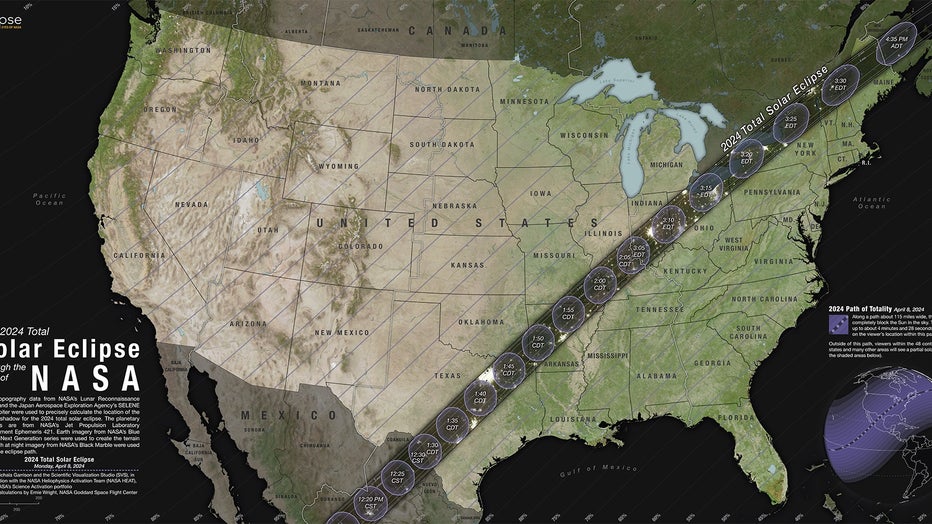
Path of solar eclipse | NASA
Future Total Solar Eclipses
Following the April 8, 2024, event, the next total solar eclipse in parts of the U.S. won't occur until 2044. Subsequently, an eclipse in August 2045 will cover a more extensive portion of the U.S.
RELATED LINKS
- 2024 Total Eclipse: Where & When
- Illinois Eclipse Events
- 16 of the coolest places to watch the solar eclipse
- Where to find free solar eclipse glasses before April 8
- What an eclipse looks like from space, and why you should see one (from Earth)
FOX Weather contributed to this report.



